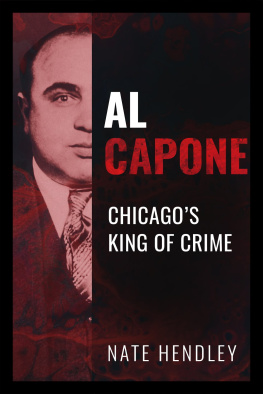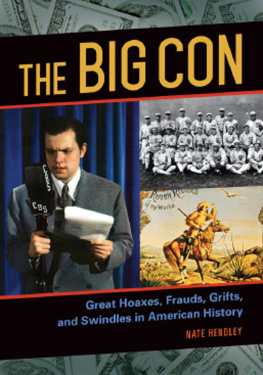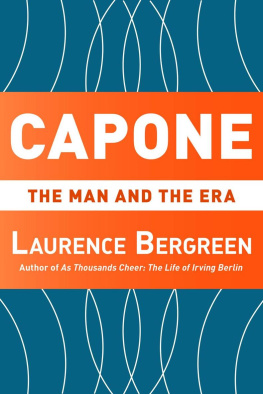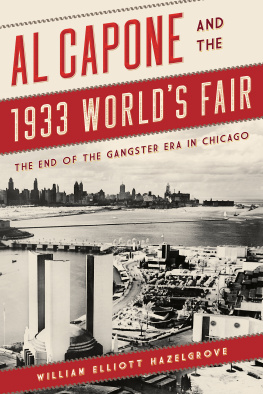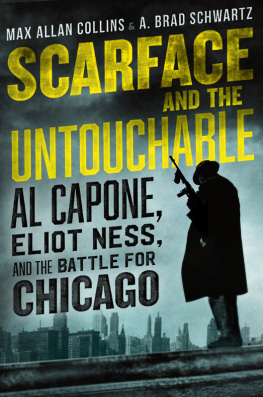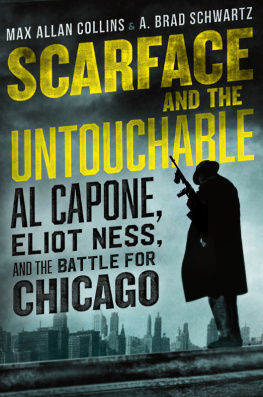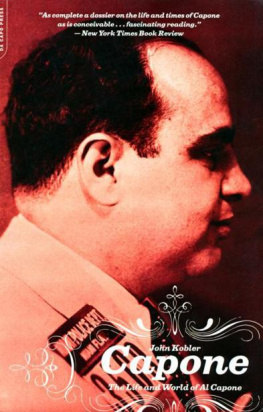Nate Hendley - Al Capone: Chicagos King of Crime
Here you can read online Nate Hendley - Al Capone: Chicagos King of Crime full text of the book (entire story) in english for free. Download pdf and epub, get meaning, cover and reviews about this ebook. City: Toronto, year: 2021, publisher: Dundurn Press, genre: Non-fiction / History. Description of the work, (preface) as well as reviews are available. Best literature library LitArk.com created for fans of good reading and offers a wide selection of genres:
Romance novel
Science fiction
Adventure
Detective
Science
History
Home and family
Prose
Art
Politics
Computer
Non-fiction
Religion
Business
Children
Humor
Choose a favorite category and find really read worthwhile books. Enjoy immersion in the world of imagination, feel the emotions of the characters or learn something new for yourself, make an fascinating discovery.
- Book:Al Capone: Chicagos King of Crime
- Author:
- Publisher:Dundurn Press
- Genre:
- Year:2021
- City:Toronto
- Rating:5 / 5
- Favourites:Add to favourites
- Your mark:
- 100
- 1
- 2
- 3
- 4
- 5
Al Capone: Chicagos King of Crime: summary, description and annotation
We offer to read an annotation, description, summary or preface (depends on what the author of the book "Al Capone: Chicagos King of Crime" wrote himself). If you haven't found the necessary information about the book — write in the comments, we will try to find it.
Al Capone: Chicagos King of Crime — read online for free the complete book (whole text) full work
Below is the text of the book, divided by pages. System saving the place of the last page read, allows you to conveniently read the book "Al Capone: Chicagos King of Crime" online for free, without having to search again every time where you left off. Put a bookmark, and you can go to the page where you finished reading at any time.
Font size:
Interval:
Bookmark:

Chicagos King of Crime
Nate Hendley

Copyright Nate Hendley, 2021
All rights reserved. No part of this publication may be reproduced, stored in a retrieval system, or transmitted in any form or by any means, electronic, mechanical, photocopying, recording, or otherwise (except for brief passages for purpose of review) without the prior permission of Dundurn Press. Permission to photocopy should be requested from Access Copyright.
Publisher: Scott Fraser | Editor: Kelly Stephens
Cover designer: Karen Alexiou
Cover images: Al Capone photo by Wide World Photos, Chicago Bureau (Federal Bureau of Investigation), public domain via Wikimedia Commons; blood background photo by Cassi Josh, unsplash.com
Library and Archives Canada Cataloguing in Publication
Title: Al Capone : Chicagos king of crime / Nate Hendley.
Names: Hendley, Nate, author.
Description: Previously published: Neustadt, Ontario: Five Rivers Chapmanry, 2010. | Includes bibliographical references.
Identifiers: Canadiana 20210225033 | ISBN 9781459749184 (EPUB)
Subjects: LCSH: Capone, Al, 1899-1947. | LCSH: CriminalsIllinoisChicagoBiography. | LCSH: Organized crimeIllinoisChicagoHistory. | LCGFT: Biographies.
Classification: LCC HV6248.C17 H45 2021 | DDC 364.1092dc23

We acknowledge the support of the Canada Council for the Arts and the Ontario Arts Council for our publishing program. We also acknowledge the financial support of the Government of Ontario, through the Ontario Book Publishing Tax Credit and Ontario Creates, and the Government of Canada.
Care has been taken to trace the ownership of copyright material used in this book. The author and the publisher welcome any information enabling them to rectify any references or credits in subsequent editions.
The publisher is not responsible for websites or their content unless they are owned by the publisher.
Dundurn Press
1382 Queen Street East
Toronto, Ontario, Canada M4L 1C9
dundurn.com, @dundurnpress 
This book is dedicated to Ruth (Wee Auntie) Hendley and to the memory of Michael (Mix) Hendley, for always having faith in me.
T he late 19th Century saw millions of Italians leave their homeland for North and South America. Poverty, caused by overpopulation, lack of industrialization, disease, deep-rooted organized crime, and inefficient land management by the rich elite, was the spur for this Diaspora. A flood of Italian immigrants sought better fortunes in the New World.
Al Capones parents, Gabriele and Teresina (called Teresa) grew up in Naples, Italys third largest city. Situated in the southern part of the country, Naples was poor, crime-ridden, and crowded.
In the late 1800s, Gabriele and Teresa decided to try their luck in America, a country that seemed fantastically rich compared to their homeland. It would be a better place to raise a family, they reasoned, than poverty-stricken southern Italy. At that time, the couple had two young boys, Vincenzo and Raffaele, and Teresa was pregnant with their third child. A barber by trade, Gabriele planned to take as many odd jobs as possible in America until he could open his own barbershop.
By the 1890s, 50,000 Italians were moving to the United States each year. It was an unprecedented wave of immigrants in a country where the majority population was Anglo-Saxon. Italians were not greeted with open arms. They were called hateful names and accused of being criminal, stupid, and lustful. Adding to popular prejudice was the fact that Italians were Catholic at a time when America was predominantly Protestant.
The Capones landed at Ellis Island in 1894 and quickly made their way to Brooklyn, which was home to many Italian immigrants. Brooklyn had been part of New York City since 1898, but it was still very much isolated from Manhattan and the rest of the city. Partly facing the Atlantic Ocean, Brooklyn was a seaport; seagulls screeched overhead, workers unloaded ship cargos on huge docks, and the air smelled of salt and grime.
The family took up residence in a vacant flat at 95 Navy Street, a four-story tenement with no indoor toilet or plumbing. The neighborhood was a slum, made worse by its proximity to the Brooklyn Naval Yard. On a regular basis, off-duty sailors could be seen strolling around the area looking for gambling clubs, alcohol, and women. The Gowanus Canal was another unappealing feature of the area. A man-made waterway designed for barges; the canal was badly polluted. Open sewers emptied their contents into the waterway and its foul smell permeated the entire neighborhood. The sluggish canal was also a favorite dumping ground for the dead bodies of people who had run afoul of local criminals.
Because he could read and write, Gabriele Capone got a job in a grocery store patronized by fellow Italians. It was a far better position than the pick-and-shovel jobs most male Italian immigrants had to take. Gabriele worked hard, as did Teresa, who took in sewing to supplement the family income.
In 1895, the couples third child, Salvatore, arrived. Then, a few years later, on January 17, 1899, a fourth Capone boy made his way into the world. Gabriele and Teresa named their newest son Alphonse. Three weeks after his birth, Alphonse was baptized at the local St. Michaels church. It was a place of worship often frequented by the Capone family, especially Teresa.
Alphonse, who would become one of Americas most notorious criminals, had a relatively normal upbringing. His father was quiet and steadya hardworking, conventional man. His mother was a warm, maternal figure who cared as best she could for her growing family. She never learned much English beyond a few basic words but that wasnt unusual for new immigrants. The boys in the Capone clan could be boisterous but werent inherently criminal.
Shortly after Alphonse was born, the Capones moved to better living quarters. Gabriele had saved enough money to open a barbershop at 69 Park Avenue in Brooklyn, and the family settled into an apartment above the shop.
The Park Avenue area was noisy and bustling with activity. Kids played stickball and other games in the streets, vendors peddled their wares, and horses clomped through the neighborhood, pulling wagons loaded with goods. Numerous bars offered alcoholic respite for the working-class population, while corner-stores provided foods from the Old World. Nearby, elevated trains raced along on overhead tracks, adding to the din. While the neighborhood was heavily Italian, there were substantial numbers of Irish and German residents, as well as other ethnic groups. Unlike some of his more clannish peers, Capone did not grow up in an exclusively Italian environment. He was exposed to an expansive worldview from a young age.
In 1904, when he was five years old, Alphonse was enrolled in public school. At the time, the education system did not look favorably on Italians. The teachers were generally young and inexperienced, barely a few years older than their charges. These instructors regarded Italian children as a lesser species who spoke fractured English and had no aptitude for learning. Italian parents, for their part, expected their children to drop out by adolescence so they could work and contribute to the family income.
Font size:
Interval:
Bookmark:
Similar books «Al Capone: Chicagos King of Crime»
Look at similar books to Al Capone: Chicagos King of Crime. We have selected literature similar in name and meaning in the hope of providing readers with more options to find new, interesting, not yet read works.
Discussion, reviews of the book Al Capone: Chicagos King of Crime and just readers' own opinions. Leave your comments, write what you think about the work, its meaning or the main characters. Specify what exactly you liked and what you didn't like, and why you think so.

